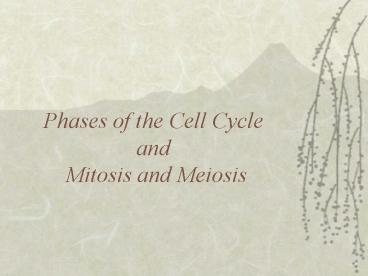Phases of the Cell Cycle and Mitosis and Meiosis - PowerPoint PPT Presentation
1 / 40
Title:
Phases of the Cell Cycle and Mitosis and Meiosis
Description:
Begins with formation of a new cell and ends with replication of that cell ... Asexual reproduction. 4 Phases of Mitosis. PROPHASE. METAPHASE. ANAPHASE. TELOPHASE ... – PowerPoint PPT presentation
Number of Views:67
Avg rating:3.0/5.0
Title: Phases of the Cell Cycle and Mitosis and Meiosis
1
Phases of the Cell Cycleand Mitosis and Meiosis
2
The Cell Cycle
- Begins with formation of a new cell and ends with
replication of that cell - An ordered sequence of events in the life of a
dividing somatic cell. - 3 phases
- Interphase
- Mitosis (M) phase
- Cytokinesis (C)
- Mitosis is part of cell cycle.
3
(No Transcript)
4
Cell Cycle Phase 1
- Interphase
- G1
- Gap, cell grows in size, normal functioning
- S
- Synthesis, DNA replication
- G2
- Cell prepares for division
5
The Cell CyclePhase 2
- Mitosis
- Divides nucleus into 2 nuclei
- Each with same chromosome number as the parent
cell - For growth and tissue repair
- Asexual reproduction
6
4 Phases of Mitosis PROPHASE METAPHASE ANAPHASE T
ELOPHASE
7
Mitosis Stages (including interphase) -- IPMAT
Interphase nuclear membrane intact chromosomes
not clearly visible DNA duplicates (92
chromosomes) Prophase chromosomes become
super-coiled and visible Metaphase chromosomes
line up along equator of cell Anaphasecentromere
/ chromosomes divide (back to 46
chromosomes)-separate to opposite
poles Telophase nuclei re-form cell starts to
divide chromosomes uncoil (cytokinesis divides
completely to form two new daughter cells)
8
DNA Basics
- Nucleus membrane-bound organelle containing
genetic information (DNA) - DNA deoxyribonucleic acid
- Chromosomes-
- structures in the cell that contain genetic
information in the form of DNA - Every organism has a distinct (humans 46),
(goldfish 94) - Contains 2 chromatids(identical parts)
9
(No Transcript)
10
Interphase
11
Prophase
- Chromosome material coils into chromosomes.
12
Metaphase
Chromosomes align in center of cell.
13
ANAPHASE
- Each chromatid
- moves towards the opposite pole.
14
TELOPHASE - chromosomes gather at the two
poles - nuclear membranes form around 2 new
nuclei
15
(No Transcript)
16
Example of Mitosis in an animal cell
17
Example of Mitosis in a plant cell
18
Mitosis Overview
Definition process by which cells divide to
create two identical cells Purpose growth of
the organism and replacement of old cells
19
The MITOTIC PHASE 1) MITOSIS -division of
nucleus 2) CYTOKINESIS -division of cytoplasm
20
(No Transcript)
21
Cytokinesis
Cytoplasm divides completely to form two
daughter cells that have the same number of
chromosomes.
22
MEIOSIS
- Cell division that reduces chromosome by half
- Process by which sex cells (sperm / egg) are
created. - 2 stages Meiosis 1, Meiosis 2
- sexually reproducing organisms
23
Chromosomes
- DNA molecule with its attached proteins
- Chromosome number
- Number of chromosomes in cells
- Differs with species
- Diploid
- 2 of each type of chromosome
- Haploid
- 1 of each type of chromosome
24
(No Transcript)
25
(No Transcript)
26
(No Transcript)
27
- Meiosis Phases
- Meiosis comes after G2 of Interphase
- Meiosis I
- Prophase IMetaphase IAnaphase ITelophase I
- Meiosis II (virtually identical to mitosis)
- Prophase IIMetaphase IIAnaphase IITelophase II
- At the end of meiosis four daughter cells are
produced. - Each of these resulting daughter cells is haploid
(egg or sperm have 1/2 DNA of mother cell)
28
MEIOSIS I
- A). PROPHASE I each chromosome duplicates
(called sister chromatids) - B). METAPHASE I- Chromosomes align at the
center - C). ANAPHASE I Chromosomes pairs separate and
move towards the opposite poles of the cell.
(sister chromatids stay together) - D). TELOPHASE I Cytoplasm divides 2 cells are
formed. Each chromosome is still double stranded.
29
(No Transcript)
30
Prophase and Metaphase I
31
Anaphase and Telophase I
32
MEIOSIS II These phases are very similar to the
corresponding mitotic phase.
- PROPHASE II DNA does not replicate
- METAPHASE II chromosomes align in center
- ANAPHASE II Centromeres divide sister
chromatids migrate separately to each pole - TELOPHASE II and CYTOKINESIS Cell division
complete - Results in four haploid daughter cells.
33
(No Transcript)
34
Prophase and Metaphase II
35
Anaphase and Telophase II
36
Summary
37
See your Biology Textbook
38
- Major differences between mitosis and meiosis
- Mitosis makes two identical daughter cells
- Meiosis makes four cells that are not identical.
These four cells have half the DNA of the mother
cell. - 2) Prophase I of meiosis crossing over occurs,
making 2 new/unique chromosomes - 3) Interphase II of meiosis chromosomes do not
replicate as in interphase I
39
Mitosis and Meiosis
- Mitosis Cell duplication
- DNA duplicates, then cell splits into two
- Meiosis Production of sex cells
- DNA duplicates cell splits into two, then again
40
(No Transcript)































